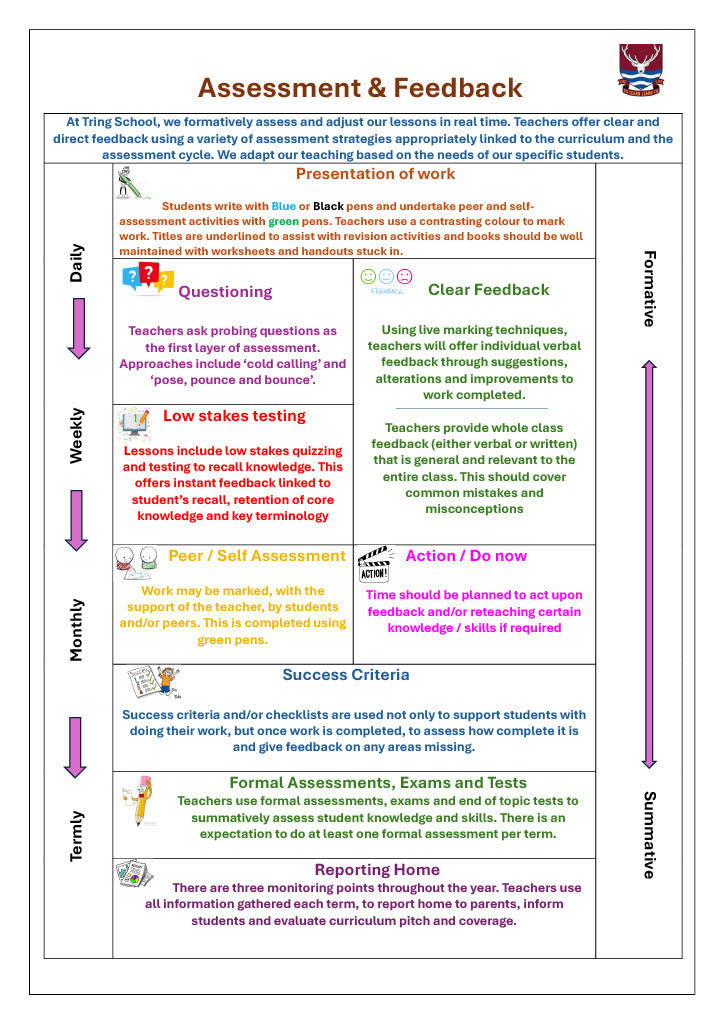Assessment & Feedback
At Tring School, we are assessing our students all of the time in lessons. We make extensive use of ‘formative assessment’, using lots of questioning, low stakes quizzes and class based activities in order to ascertain what students know and don't know and can do or not do.
Most importantly our teachers are reactive to any misconceptions or gaps in understanding using this information to offer feedback and plan future lessons.
Teachers offer lots of individual feedback as required and if it appears that a group of students need help they will offer whole class feedback accordingly. We encourage our teachers to make use of 'green pen' peer self-assessment because we feel this engagement with the work by the students is much more powerful for their learning than waiting for the teacher to mark their work in the middle or end of a unit. Many subject ‘topics’ last for around half a term and a more detailed breakdown can be found on our Curriculum maps and Assessment Overviews found here.
Summative assessments, which assess students for their learning across a whole term, allow teachers to see the progress made by the students over time, check their understanding, and highlight areas requiring further work.
In Year 7 & 8, student work is marked numerically, as percentages, or linked to specific success criteria. This mark will then be used to allocate their attainment band for that term. Please note, Computer Science, Design & Technology, Music and Physical Education will assess students against success criteria over the year as a whole, so their percentages may start off quite low for the Autumn term. In Years 9-11, assessments use the GCSE 1-9 grade system with 9 being the highest At sixth form assessments use A* to E grades.
These documents set out when students will be completing formal, marked assessments which will contribute to their ‘attainment band’ or ‘markbook average’ grade on Go 4 Schools. The information provided may need to change throughout the year and the timings are approximations. In addition to these formal assessments, students are assessed and receive feedback every day as part of their lessons.
Assessment Overviews can be found on this page
Feedback for Progress
Feedback and the dialogue between students and teachers is a crucial aspect of the teaching and learning cycle and takes place in a number of forms at Tring School, all of which are valuable and used to offer clear and direct feedback on any misconceptions or gaps in understanding.
Feedback is really important for guiding future learning and moving forward (what is going to be done differently). We utilise a number of feedback approaches as detailed on the diagram, and recognise that simple and more subtle feedback is as equally valuable or as useful. This includes verbal feedback, the referencing of success criteria when ideas are explained or shared, offering examples of work and modelling, the use of checklists, to name a few.
Teaching staff regularly plan opportunities within lessons for time to be spent by students responding to feedback and making improvements to their work. The expectation is that teachers will use a variety of these methods as appropriate to the work being undertaken.
Feedback should not focus on just one method as each is valuable. Longer assessments lend themselves to the use of success criteria, and the percentage/grades achieved are then recorded in G4S. Whereas, shorter quizzes, some exam questions or shorter tasks link to self/peer assessment led by the teacher and whole class feedback.
It is expected that at least one piece of work per term is formally assessed by the teacher, and in Year 9 to Year 13, one formal examination should take place per year with feedback on areas of strength and areas to revise.

Documents
| Assessment & Feedback |
|---|
| Assessment & Feedback Poster (pdf) |

